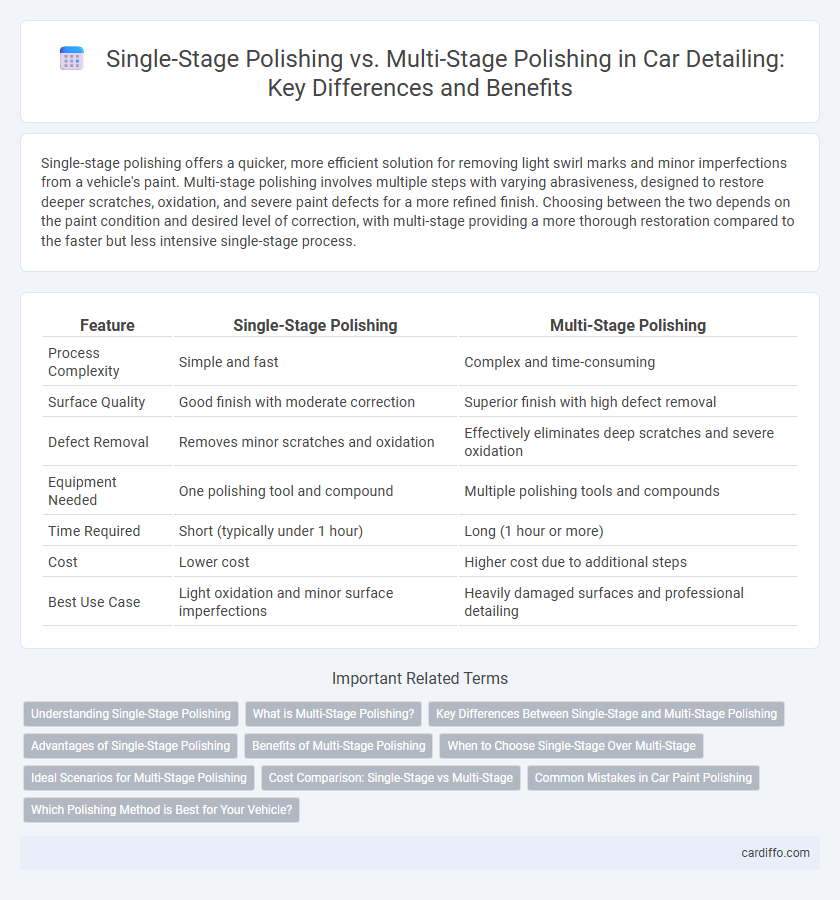Single-stage polishing offers a quicker, more efficient solution for removing light swirl marks and minor imperfections from a vehicle's paint. Multi-stage polishing involves multiple steps with varying abrasiveness, designed to restore deeper scratches, oxidation, and severe paint defects for a more refined finish. Choosing between the two depends on the paint condition and desired level of correction, with multi-stage providing a more thorough restoration compared to the faster but less intensive single-stage process.
Table of Comparison
| Feature | Single-Stage Polishing | Multi-Stage Polishing |
|---|---|---|
| Process Complexity | Simple and fast | Complex and time-consuming |
| Surface Quality | Good finish with moderate correction | Superior finish with high defect removal |
| Defect Removal | Removes minor scratches and oxidation | Effectively eliminates deep scratches and severe oxidation |
| Equipment Needed | One polishing tool and compound | Multiple polishing tools and compounds |
| Time Required | Short (typically under 1 hour) | Long (1 hour or more) |
| Cost | Lower cost | Higher cost due to additional steps |
| Best Use Case | Light oxidation and minor surface imperfections | Heavily damaged surfaces and professional detailing |
Understanding Single-Stage Polishing
Single-stage polishing utilizes a compound designed to cut and polish in one step, making it ideal for light surface imperfections and regular maintenance. This method saves time and effort by combining correction and finishing processes, maintaining paint clarity and gloss without the need for multiple products. Single-stage polishing is most effective on mildly oxidized or lightly scratched paint surfaces, offering a quick restoration for everyday vehicle detailing.
What is Multi-Stage Polishing?
Multi-stage polishing is an advanced automotive detailing process that uses a sequence of different abrasive compounds and polishing pads to progressively refine a vehicle's paint surface. This method effectively removes deeper scratches, oxidation, and swirl marks that single-stage polishing cannot fully eliminate, resulting in a higher level of gloss and paint clarity. Professional detailers often employ multi-stage polishing to restore or enhance the finish on high-end cars, achieving showroom-quality results.
Key Differences Between Single-Stage and Multi-Stage Polishing
Single-stage polishing uses one compound to remove imperfections and achieve shine, offering a quicker, less labor-intensive process ideal for light defects. Multi-stage polishing involves a combination of cutting, polishing, and finishing compounds to tackle deeper scratches and oxidation, resulting in a higher quality, longer-lasting finish. The choice between single-stage and multi-stage depends on the paint condition, desired finish, and time available for detailing.
Advantages of Single-Stage Polishing
Single-stage polishing offers the advantage of time efficiency by combining compounding and polishing into one step, reducing labor and operational costs. This method is ideal for lightly oxidized or moderately scratched surfaces, providing a quick restoration of gloss with minimal product usage. It also minimizes the risk of clear coat damage by eliminating multiple abrasive stages, making it suitable for regular maintenance and quick detailing jobs.
Benefits of Multi-Stage Polishing
Multi-stage polishing enhances paint correction by using progressively finer compounds and pads, resulting in superior swirl and scratch removal compared to single-stage polishing. This technique restores deeper paint clarity and gloss, delivering a showroom-quality finish that single-stage methods often cannot achieve. The meticulous process also reduces the risk of paint damage by allowing controlled correction in multiple phases.
When to Choose Single-Stage Over Multi-Stage
Single-stage polishing is ideal for vehicles with minor swirl marks, light oxidation, or regular maintenance to quickly restore shine without extensive correction. Choose single-stage polishing when the paint surface is relatively healthy, requiring a faster process with less aggressive compounds to preserve clear coat integrity. Multi-stage polishing is better suited for heavily oxidized or deeply scratched surfaces that need extensive correction beyond the capabilities of a single-step product.
Ideal Scenarios for Multi-Stage Polishing
Multi-stage polishing is ideal for severely oxidized, scratched, or neglected paint surfaces requiring comprehensive correction to restore gloss and clarity. This approach is beneficial for classic cars, high-value vehicles, or show cars where achieving a flawless, deep mirror finish is paramount. Detailing professionals leverage multiple abrasive steps combined with varying polish compounds to progressively refine the surface, eliminating defects that single-stage polishing cannot effectively address.
Cost Comparison: Single-Stage vs Multi-Stage
Single-stage polishing typically costs less upfront due to fewer materials and less labor time, making it ideal for budget-conscious detailing. Multi-stage polishing involves more products and extended work, increasing overall expense but delivering superior paint correction and lasting finish. The cost difference reflects the trade-off between immediate affordability and long-term quality results in automotive detailing.
Common Mistakes in Car Paint Polishing
Frequent errors in car paint polishing include using an overly aggressive polishing technique during single-stage polishing, which can cause paint thinning and swirl marks. Multi-stage polishing mistakes often involve skipping necessary steps, resulting in uneven surface correction and residual haze. Proper pad selection and polishing speed control are critical to avoid these common pitfalls and achieve a flawless finish.
Which Polishing Method is Best for Your Vehicle?
Single-stage polishing offers a quick and efficient solution for vehicles with minor paint imperfections, using one compound to restore shine. Multi-stage polishing involves multiple steps with different polishes and pads, providing deeper correction for severe scratches and oxidation. Choosing the best method depends on your vehicle's paint condition and desired finish, with multi-stage polishing delivering superior results for heavily damaged surfaces.
Single-Stage Polishing vs Multi-Stage Polishing Infographic

 cardiffo.com
cardiffo.com